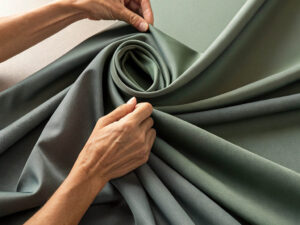From yoga to running to gym training, stretch is non-negotiable in activewear. But not all stretchy fabrics are made equal. So, what exactly is the stretch fabric used in most activewear?
The most common stretch fabrics used in activewear are blends of synthetic fibers like nylon or polyester combined with spandex (also known as elastane or Lycra). These blends allow for 4-way stretch, shape retention, and moisture management—making them ideal for performance.
Let’s explore the best stretch fabrics for activewear, what makes them perform so well, and how to choose the right one for different activities and body needs.
What makes a fabric stretchy?
Stretch comes down to fiber content and fabric construction.
Stretch fabric is created by blending elastic fibers (like spandex) with base fibers (like polyester or nylon) and using knit structures that allow multidirectional movement.
Two Types of Stretch:
- 2-way stretch – Moves horizontally (left to right)
- 4-way stretch – Moves horizontally and vertically (best for activewear)
Key Fiber That Adds Stretch:
✔ Spandex (Elastane/Lycra) – Adds elasticity and recovery
✔ Content: 5%–25% in most activewear garments
✔ Performs best when paired with polyester or nylon
No spandex = no snap-back. It’s the essential ingredient in stretchy, form-fitting workout clothing.
What are the top stretch fabrics used in activewear?
Let’s break down the most common stretch materials you’ll find in your favorite workout clothes.
1. Nylon-Spandex1
✔ Soft, silky hand feel
✔ Excellent shape retention
✔ High stretch and flexibility
✔ Moisture-wicking and quick-dry
Best for: Yoga leggings, cycling shorts, running tights
2. Polyester-Spandex2
✔ Durable and sweat-resistant
✔ Quick-drying
✔ Slightly more compressive
✔ Holds color well
Best for: Gym training, HIIT, hot yoga
3. Cotton-Spandex
✔ Soft and breathable
✔ Moderate stretch
✔ May lose shape over time
✔ Not ideal for heavy sweat
Best for: Casual wear, gentle yoga, lounging
4. Modal-Spandex or Bamboo-Spandex
✔ Ultra-soft and eco-conscious
✔ Lightweight and breathable
✔ Low compression
✔ May stretch out over time
Best for: Restorative yoga, athleisure, low-impact wear
These blends all perform differently depending on the activity—and your body’s needs.
What is spandex, elastane, or Lycra?
They’re all the same stretchy superstar—just different names.
Spandex (in the US), elastane (in Europe), and Lycra (a brand name) refer to the same synthetic fiber known for its exceptional elasticity.
Spandex Highlights:
✔ Can stretch up to 500% of its length
✔ Recovers instantly without sagging
✔ Lightweight and resistant to sweat
✔ Blended with other fibers to create performance stretch
Even a small percentage (5–10%) can transform a rigid fabric into flexible activewear.

How does knit structure affect stretch?
It’s not just the fiber—the way the fabric is knit also matters.
Activewear is often made from circular or warp-knit fabrics, which allow the garment to move in every direction without deforming.
Common Knit Structures:
- Jersey Knit – Smooth and stretchy, ideal for leggings and tees
- Interlock Knit – Slightly thicker, more supportive
- Rib Knit – Highly stretchable and form-fitting
- Compression Knit – Dense and structured for sculpting
These structures combined with spandex create the perfect stretch matrix.
How do different stretch fabrics compare?
Here’s a quick breakdown of how the top stretch fabrics stack up.
| Fabric Blend | Stretch | Breathability | Compression | Best For |
|---|---|---|---|---|
| Nylon-Spandex | ★★★★★ | ★★★★☆ | ★★★☆☆ | Yoga, Pilates, Dance |
| Polyester-Spandex | ★★★★☆ | ★★★☆☆ | ★★★★☆ | HIIT, Running, Gym |
| Cotton-Spandex | ★★★☆☆ | ★★★★★ | ★★☆☆☆ | Lounge, Light Activity |
| Modal/Bamboo-Spandex | ★★★☆☆ | ★★★★☆ | ★★☆☆☆ | Stretching, Athleisure |
| Compression Poly/Spandex | ★★★☆☆ | ★★★☆☆ | ★★★★★ | Training, Sculpting |
Choose based on your preferred balance between stretch and structure.
What stretch fabrics are best for different types of workouts?
Matching fabric to function helps avoid discomfort or sagging during your session.
Workout-Specific Fabric Picks:
| Activity | Ideal Fabric |
|---|---|
| Yoga / Pilates | Nylon-spandex, soft jersey with 4-way stretch |
| Running | Polyester-spandex with sweat-wicking finish |
| Strength Training | Compression knit with polyester-spandex |
| Cycling | High-compression nylon-spandex blends |
| Walking / Stretching | Modal or cotton-spandex for breathability |
| Dance / Barre | Silky, smooth nylon-spandex for flexibility |
Stretch matters most in high-motion, multi-directional workouts.

How to identify good stretch fabric in-store or online?
A little testing goes a long way.
In-Store Fit Test:
✔ Stretch test – Gently pull the fabric. Does it snap back smoothly?
✔ Squat test – Check for sheerness or overstretching
✔ Touch – Soft = comfort; dense = compression
✔ Hold to light – Check for even density
Online Clues:
✔ Fabric listed as “4-way stretch”
✔ Includes spandex/elastane in the blend
✔ Descriptions like “moisture-wicking,” “sculpting,” or “technical knit”
✔ Reviews mention fit, bounce-back, or compression
When in doubt, go for performance labels from athletic brands—they’re engineered for stretch.
Are there sustainable stretch fabrics?
Yes—eco-stretch is on the rise.
Examples:
- Recycled Polyester-Spandex (rPET) – Same performance, less waste
- TENCEL™ with elastane – Soft, breathable, and plant-based
- ROICA™ / Creora™ – More sustainable alternatives to Lycra
Look for certifications like OEKO-TEX or Bluesign to ensure environmental safety.
Conclusion
The best stretch fabric for activewear is a blend of synthetic fibers like nylon or polyester with spandex. These materials allow for 4-way stretch, shape retention, and moisture management—everything you need in high-performance, movement-ready clothing. Whether you’re flowing through yoga or sprinting on the track, the right stretch fabric supports every move.














